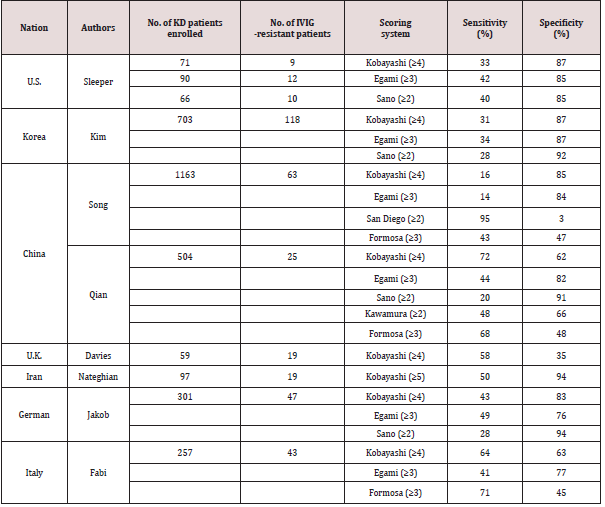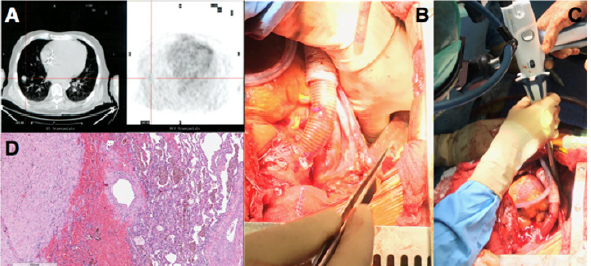Lupine Publishers | Advancements in Cardiology Research & Reports
It is important to predict Kawasaki Disease (KD) patients who will be
resistant to Intravenous Immunoglobulin (IVIG) before
starting the initial treatment, as these patients may have severe
inflammation and vasculitis, which will likely lead to the development
of Coronary Artery Lesions (CALs). An intensive initial treatment
combined with IVIG and additional anti-inflammatory drugs is
reported to reduce the occurrence of IVIG resistance and CALs. Although
risk scoring systems using usual laboratory data to predict
IVIG-resistant patients have mainly been developed in Japan, these
systems did not accurately predict non-responders to IVIG
among patients in the other countries. In this review, we provide a
comprehensive overview of the main risk scoring systems and
evaluate the relevant literature.
Kawasaki Disease (KD) is an acute systemic vasculitis that
mainly occurs in infants and young children [1]. Although
intravenous Immunoglobulin (IVIG) is an effective treatment
for KD [2], approximately 10-20% of KD patients are resistant to
IVIG therapy [2,3]. IVIG-resistant patients with KD have a higher
risk of developing coronary artery lesions (CALs) than responders
to IVIG therapy [4,5]. It is important to predict IVIG-resistant KD
patients before starting the initial treatment, because intensive
initial combination therapy with IVIG and other anti-inflammatory
drugs, such as Ulinastatin [6], steroid [7,8] and infliximab [9],
may reduce the occurrence of IVIG resistance and/or CALs. There
are several risk scoring systems for predicting IVIG resistance in
KD patients; the Kobayashi [10], Egami [11] and Sano [12] risk
scores have been commonly used in Japan. Recently, we reported
a new risk scoring system using two blood cell subtype ratios, the
neutrophil-lymphocyte ratio (NLR) and the platelet-to-lymphocyte
ratio (PLR) [13]. Furthermore, several researchers have reported
other risk scoring systems in such countries as the U.S. [14], Taiwan
[15] and China [16-18]. The aim of this review is to compare the
predictive validity among these risk scoring systems and assess
their problems and limitations.
The main risk scoring systems for predicting the IVIG resistance
in KD, which have been reported to date, are summarized in Table
1. The parameters of the Egami score [11] consist of alanine
aminotransferase (ALT) ≥80 IU/L (2 points), age ≤6 months (1
point), days of illness ≤4 days (1 point), C-reactive protein (CRP)
≥8 mg/dl (1 point) and platelet count ≤300×103/mm3 (1 point).
In the high-risk group (score ≥3), the sensitivity and specificity in
the prediction of IVIG resistance were 78% and 76%, respectively.
The parameters of the Sano score [12] consist of Aspartate Amino
Transferase (AST) ≥200 IU/L (1 point), CRP ≥7 mg/dl (1 point)
and total bilirubin ≥0.9 mg/dl (1 point). In the high-risk group
(score ≥2), the sensitivity and specificity in the prediction of IVIG
resistance were 77% and 86%, respectively. The parameters of the
Kobayashi score [10] consist of sodium ≤133 mmol/L (2 points),
days of illness at initial treatment ≤4 days (2 points), AST ≥100
IU/L (2 points), % of neutrophils ≥80 (2 points), CRP ≥10 mg/dl
(1 point), age ≤12 months (1 point) and platelet count ≤300×103/
mm3 (1 point). In the high-risk group (score ≥4), the sensitivity
and specificity in the prediction of IVIG resistance were 86% and 68%, respectively. Recently, Kawamura et al. reported that the
combination of NLR ≥3.83 and PLR ≥150 is a useful predictor of
IVIG resistance in KD [13], and the sensitivity and specificity of NLR
≥3.83 and PLR ≥150 in the prediction of IVIG resistance were 71%
and 69%, respectively. These simple ratios are convenient and costeffective
in comparison to other scoring systems.
Table 1: Risk scoring systems predicting IVIG resistance in KD patients.

ALT, alanine aminotransferase; AST, aspartate aminotransferase; CRP,
C-reactive protein; GGT, γ-glutamyl transferase; NLR, neutrophil-
lymphocyte ratio; PLR, platelet to lymphocyte ratio; PLT, platelet;
zHgb, age-adjusted hemoglobin concentration.
In the US, the San Diego score [14] was proposed. The
parameters consist of % of bands ≥20 (2 point), illness days≤4 (1
point), γ-glutamyl transferase (GGT) ≥60 IU/L and age-adjusted
hemoglobin concentration (zHgb) ≤-2. In the high-risk group
(score ≥2), the sensitivity and specificity in the prediction of
IVIG resistance were 73% and 62%, respectively. In Taiwan, the
Formosa score [15] was reported. The parameters consists of % of
neutrophils ≥60 (2 points), albumin <3.5 g/dl (1 point) and positive
lymphadenopathy (1 point). In the high-risk group (score ≥3), the
sensitivity and specificity in the prediction of IVIG resistance were
86% and 81%, respectively. In China, Fu et al. reported a scoring
system. The parameters consist of % of neutrophils ≥80 (2 points),
illness days ≤4 (1 point), CRP ≥8 mg/dl (2 pint), polymorphous
exanthema (1 point) and change around the anus (1 point) [16]. In
the high-risk group (score ≥4), the sensitivity and specificity in the
prediction of IVIG resistance were 54% and 71%, respectively. Tang
et al. reported another scoring system. The parameters consist of
age <6 months (2 points), albumin 3.5 < g/dl (2 points), edema of
extremities (1 point), rash (1 point) and % of neutrophils ≥80 (1
point) [17]. In the high-risk group (score ≥3), the sensitivity and
specificity in the prediction of IVIG resistance were 71% and 76%,
respectively. Recently, Hua et al. reported a new scoring system. The
parameters consist of fever duration ≥7 days (2 points), delayed
diagnosis (1 point), GGP ≥25 mg/dl (1 point), sodium < 135 mmol/L
(1 point), NLR ≥2.8 (1 point) and platelet count ≤350×103/mm3
(1 point) [18]. In the high-risk group (score ≥4), the sensitivity
and specificity in the prediction of IVIG resistance were 61% and
67%, respectively. As described above, each of risk scoring systems
are determined based on different clinical data and symptoms,
although some factors are duplicated among these scoring systems.
There are differences in the definition of IVIG resistance in each
study. Egami defined IVIG resistance as persistent fever (≥37.5℃)
and a fall in CRP by <50% within 48 hours after IVIG therapy [11].
Sano defined IVIG resistance as persistent fever (≥37.5℃ over 24
hours) after finishing IVIG therapy [12]. Kobayashi and Kawamura
defined IVIG resistance as persistent fever lasting >24 hours after
the
completion of the initial treatment or in the presence of recrudescent
fever associated with KD symptoms after an afebrile period [10,13].
The San Diego score defined IVIG resistance as persistent fever
(≥38.0℃ rectally or orally) for at least 48 hours but no longer than
7 days after IVIG therapy [14]. The Formosa score defined IVIG
resistance as persistent fever or development of recrudescent fever
associated with KD symptoms after afebrile period [15]. Fu and
Hua defined IVIG resistance as persistent or recrudescent fever at
any time 48 hours to 2 weeks after IVIG therapy and at least 1 of the
standard diagnostic criteria [16,18]. Tang defined IVIG resistance
as recrudescent or persistent fever ≥36 hours after the end of IVIG
infusion [17]. Thus, because the definition of IVIG resistance has
not been standardized, international consensus will be needed in
the near future. In the 2017 Kawasaki disease guidelines from the
American Heart Association, the definition of IVIG resistance was
recrudescent or persistent fever at least 36 hours after the end of
IVIG infusion [19].
Several authors have assessed the sensitivity and specificity
of risk scoring systems when they were applied to KD patients in
the other countries (Table 2). The Kobayashi risk score (≥4), Egami
risk score (≥3) and Sano risk score (≥2) have good specificity (87%,
85% and 85%, respectively) but low sensitivity (33%, 42% and
40%, respectively) for predicting IVIG resistance in KD patients in
North America [20]. Similarly, the Kobayashi risk score (≥4), Egami
risk score (≥3) and Sano risk score (≥2) have good specificity (87%,
87% and 92%, respectively) but low sensitivity (31%, 34% and
28%, respectively) for predicting IVIG resistance in KD patients in
Korea [21]. In KD patients in China, Song et al. reported that the
Kobayashi risk score (≥4) and Egami risk score (≥3) have good
specificity (85% and 84%, respectively) but low sensitivity (16%
and 14%, respectively), the San Diego risk score (≥2) has high
sensitivity (95%) but very low sensitivity (3%), and the Formosa
score (≥3) has relatively low specificity (47%) and sensitivity
(43%) for predicting IVIG resistance [22]. Qian et al. reported that
the sensitivity of Kobayashi risk score (≥4), Egami risk score (≥3),
Sano risk score (≥2), Kawamura risk score (≥2) and Formosa score
(≥3) were 72%, 44%, 20%, 48% and 68%, respectively, and that
the specificity of these scores were 62%, 82%, 91%, 66% and 48%,
respectively [23]. In the United Kingdom, the Kobayashi risk score
(≥4) had relatively low sensitivity (58%) and low specificity (35%)
[24]. In the Kobayashi score, a cut-off risk score of 5 points was also
reported to be effective for predicting IVIG resistance in Japanese
patients with KD [7,25]. The Kobayashi risk score (≥5) is reported
to predict IVIG resistance in Iranian patients with KD, with 50%
sensitivity and 94% specificity [26].
Table 2: Sensitivity and Specificity of risk scoring systems when applied to different ethnic group.

Recently, Jakob et al. reported that the Kobayashi risk score (≥4),
Egami risk score (≥3) and Sano risk score (≥2) have low sensitivity
(43%, 49% and 28%, respectively), although they have relatively
high specificity (83%, 76% and 94%, respectively), in German
patients with KD [27]. More recently, Fabi et el. reported that the
Kobayashi risk score (≥4), Egami risk score (≥3) and Formosa
score (≥3) are ineffective for predicting IVIG resistance (sensitivity:
64%, 41% and 71%, respectively; specificity: 63%, 77% and 45%,
respectively) in Italian children with KD [28]. Besides, the ability
of NRL and PLR to predict IVIG resistance in KD was evaluated in
China: the cut-off values of NLR ≥4.36 and PLR ≥162 were useful
for predicting IVIG-resistance in KD [29], and NLR ≥2.51 was useful
in KD patients younger than 1 year of age [30]. Although there is a
slight difference in the cut-off values of Japan [13] and China [29],
the effectiveness of the NLR and PLR in predicting IVIG resistance
has been proven in both countries.
Many of the Japanese scoring systems (Egami, Sano and
Kobayashi scores) had relatively good specificity but low sensitivity
when they were applied to non-Japanese KD patients. These results
indicate that the use of Japanese risk scores in other countries can
exclude most patients who do not require additional therapy (lowrisk
patients) but cannot accurately extract patients who require
additional therapies (high-risk patients). For this reason, these
Japanese risk scores have not been widely used outside Japan.
These regional differences could be due to genetic differences or
other environmental factors [31]. It is reported that the functional
polymorphism and methylation of the immunoglobulin gamma
Fc region receptor II-a (FCGR2A) gene might be associated with
IVIG resistance in KD patients [32,33]. As there is a difference in
the incidence of KD among countries, the disease severity and
the effectiveness of IVIG therapy might also be different. It seems
difficult to establish a universal risk scoring system for IVIG
resistance in KD due to racial differences. Thus, it might be better
to aim to establish discrete risk scoring systems for each country.
It would be preferable if the risk score is simple and convenient.
The determination of cut-off values for the NLR and PLR in each
country may warrant investigation because these ratios are easily
calculated. In summary, the prediction of failure to respond to
IVIG therapy is important for identifying KD patients who may
need additional anti-inflammatory treatments, because intensive
therapy can be reduce the incidence of IVIG resistance and CAL
formation. Although several risk scoring systems of IVIG resistance
have been proposed, many of these failed to effectively predict
IVIG resistance in other countries. Further studies will be needed
to obtain consensus on a risk scoring system for predicting IVIG
resistance in KD.
For more Lupine Publishers Click on Below link
https://publons.com/publisher/7295/lupine-publishers-llc








